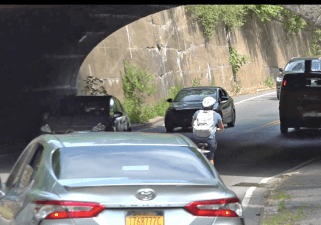The Prospect Park Road Diet: A Big Improvement That Only Goes Halfway

At a public meeting tonight, the Prospect Park Road Sharing Task Force will present a plan to double the amount of space for pedestrians on the Prospect Park loop and reduce confusion between pedestrians and cyclists during the vast majority of time that the park is car-free.
The Prospect Park Alliance established the task force last July in the wake of a collision where a cyclist traveling on a downhill seriously injured a pedestrian. Prospect Park Administrator Emily Lloyd told the Times that the task force, which includes a broad array of park users, city agencies, elected officials, and advocates, has reached an “enthusiastic consensus” for reconfiguring the loop drive with one fewer lane for cars and more space for walking and biking.
Currently the loop drive is open to motor traffic from 7-9 a.m. on the east side of the park and from 5-7 p.m. on the west side. During those hours, when people take advantage of the park before and after the work day, thousands of pedestrians and cyclists cram into the narrow confines of the marked walking and biking lanes, while most of the loop is given over to car commuters. The motorists have more space than they know what to do with: A speed gun survey conducted by the Prospect Park Youth Advocates in 2008 found that 90 percent of drivers on the loop exceed the 25 mph speed limit.
Meanwhile, during the entire weekend and the 22 hours each weekday when any given segment of the loop is car-free, the markings make little sense. Scattered signs explain that cyclists should use the “traffic lanes” while pedestrians have the run of the “bike lane,” but the street markings are omnipresent. The confusion about who belongs where is often cited as a factor contributing to bike-ped collisions on the loop.
The task force proposal will give some breathing room to pedestrians and cyclists during the a.m. and p.m. crunch, and it should get more drivers to adhere to the speed limit. It’s a big improvement. But a comprehensive fix would go farther, making Prospect Park car-free 24 hours a day. As long as there’s a motor vehicle lane in Brooklyn’s flagship park, people on the loop will still be exposed to fast-moving cars, and street markings won’t match the actual rules most of the time.
The campaign for a car-free Prospect Park has a long and effective history, gradually reclaiming the park drive after Robert Moses turned it into a 24/7 motorway in the 1930s. The first mayor to start undoing the Moses legacy was John Lindsay, who introduced car-free weekends in 1966. In recent years, as traffic in the park has dwindled to about 700 cars per hour during rush hours, City Council members representing districts that abut the park have signed on to support a three-month car-free trial in the summers. In 2002 and again in 2005, every council member from a neighboring district supported the trial concept, which the city has yet to try.
The idea of reaching a road diet compromise, with one traffic lane instead of two, picked up steam back in 2008, after the Prospect Park Youth Advocates and Transportation Alternatives delivered 10,000 signatures to Mayor Bloomberg calling for a car-free park. Then as now, opponents of a car-free park sought expanded auto access as part of the deal. Back then, CB 7 chair Randy Peers wanted to increase the loop drive speed limit. Today, Borough President Marty Markowitz wants 30 more minutes of traffic inside the park, even though the road diet is projected to cost motorists all of six or seven seconds, while the two-lane configuration encourages drivers to speed.
The movement for a car-free Prospect Park is going strong. A new Facebook group has picked up hundreds of members this week, and they’ll be speaking up at tonight’s meeting. If you want to weigh in on the future of Prospect Park, the task force meeting starts at 6 p.m. at the Prospect Park Picnic House.

